 Castles of Scotland
Castles of Scotland 

Scotland has many wonderful old castles and I wish that I could visit each and every one of them. But, since I cannot,then perhaps this is one way to go about at least having a "virtual" visit. Hope you enjoy!
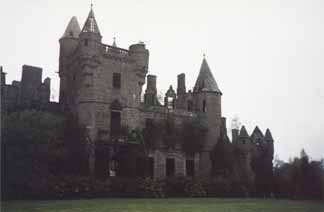
 It's best known patient was Rudolph Hess who was treated for injuries sustained while parachuting into Scotland. The roof was removed in 1955 to avoid paying tax on the property and the castle quickly deteriorated into the state shown in these pictures. (This was a real shame as the tax law was in effect for only a short time.) Today it is a condemmed building with trees growing out of it and posted warnings to keep well back from the walls. (It should be noted that no Buchanans ever lived in the castle!)
It's best known patient was Rudolph Hess who was treated for injuries sustained while parachuting into Scotland. The roof was removed in 1955 to avoid paying tax on the property and the castle quickly deteriorated into the state shown in these pictures. (This was a real shame as the tax law was in effect for only a short time.) Today it is a condemmed building with trees growing out of it and posted warnings to keep well back from the walls. (It should be noted that no Buchanans ever lived in the castle!) Craig Buchanan's "Clan Buchanan" site
Craig Buchanan's "Clan Buchanan" site Thank you, Craig for allowing me to share this on my page!

The name Eilean Donan is Gaelic for Island of Donan, a 7th century saint who is thought to have lived here as a religious hermit.
The missionary work of Abbot Donan (who was reputedly a contemporary of famousSaint Columba) took him from SW Scotland through Ayrshire northwards and into Sutherland. Presumably he then passed westwards for churches bearing his name exist in Loch Carron, Loch Broom, Kildonan in Skye and at Eilean Donan where a small oratory or cell stood. He then moved to a monastic foundation on Eigg where while celebrating the Holy Eucharist on Sunday 17 April 618 the monastery was raided by a band of marauders and Abbot Donan together with 52 of his companions were beheaded.
"...and there came robbers of the sea on a certain time to the island when he was celebrating mass. He requested of them not to kill him until the mass said, and they gave him this respite; and he was afterwards beheaded and 52 of his monks along with him." Extract from the Martyrology of Donegal.
There is another interesting story about the origins of the castle's name. A local legend speaks of the King of Otters who made his home on this islet and was distinguished by his coat of pure silver and white. When the creature died, he was buried on the spot where the castle now stands. Since the Gaelic for otter is 'Cu-Donn' some believe that this is how Eilean Donan got its name. A good story, but unlikely to be true!
As for the castle's destruction, there are several versions. One is that the troops from the English ships entered the castle, discovered the gun powder and damaged enough of the building to render it unusable - leaving it open to the ravages of time and the weather (by which it subsequently fell into complete ruin). However the Dornie Manuscript contains a different account of the destruction of Eilean Donan Castle:
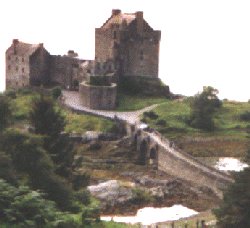 "At this Juncture Colonel Donald Murchison and Christopher MacRae son of Inverinate were busily engaged in fortifying the stronghold of Donan Castle and shortly thereafter a Government ship of war went into Lochduich, and opened a brisk fire on the Castle which the defenders found to be irresistible. Colonel Donald Murchison with his customary intrepid and vivid conceptions came to the conclusion that if Government got possession of the castle, a garrison would be planted there; that it would then become impossible to defend the country from the depredation of the Red Coats, and that they (the Sasanachs) would become a source of great annoyance to the Earl of Seaforth and his faithful adherants; therefore he concluded in the dilemma that their safest course would be to blow up the castle by setting a match to the powder magazine in the Fort, which proposition was at once complied with, so that it was laid in ruins. Tradition says that all the silver plate and other valuables in the Castle were thrown into the Fort."
"At this Juncture Colonel Donald Murchison and Christopher MacRae son of Inverinate were busily engaged in fortifying the stronghold of Donan Castle and shortly thereafter a Government ship of war went into Lochduich, and opened a brisk fire on the Castle which the defenders found to be irresistible. Colonel Donald Murchison with his customary intrepid and vivid conceptions came to the conclusion that if Government got possession of the castle, a garrison would be planted there; that it would then become impossible to defend the country from the depredation of the Red Coats, and that they (the Sasanachs) would become a source of great annoyance to the Earl of Seaforth and his faithful adherants; therefore he concluded in the dilemma that their safest course would be to blow up the castle by setting a match to the powder magazine in the Fort, which proposition was at once complied with, so that it was laid in ruins. Tradition says that all the silver plate and other valuables in the Castle were thrown into the Fort."
Eilean Donan Castle has become one of Scotland's most photographed castles this century thanks to its picturesque setting on an islet in Loch Duich by the main road to Kyle of Lochalsh, gateway to the Isle of Skye.
The castle was featured in the 1984 movie "Highlander" which starred Christopher Lambert and Sean Connery. Copies of the video are available for sale at the castle. In the Billeting Room there is at least one photograph which was taken during the filming. Other movies have also featured the castle as a result of its being so picturesque.
 Eilean Donan Castle
Eilean Donan Castle
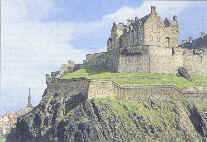
Within the confines of the Castle, there is much to see. It was the seat (and regular refuge) of Scottish Kings, and the historical apartments include the Great Hall, which now houses an interesting collection of weapons and armour.
The Royal apartments include a tiny room in which Mary, Queen of Scots gave birth to the boy who was to become King James VI of Scotland and James 1 of England upon the death of Queen Elizabeth in 1603. The ancient Honours of Scotland - the Crown, the Sceptre and the Sword of State - are on view in the Crown Room. Nearby is the Scottish National War Memorial, a building designed and created shortly after the First World War; many who enter find the experience a moving one.
Edinburgh Castle is also the home of the One O'Clock Gun. This is fired every day except Sunday at precisely 1.00pm to provide everyone with an accurate check for their clocks and watches. It will certainly startle you if you are anywhere near the Castle at that moment!
 The Castle Esplanade is the venue of the world-famous Edinburgh Military Tattoo, the annual occasion on which, over a period of three weeks in August, the Army presents a lively programme of music, marching and historical re-enactments under floodlights before large and appreciative audiences.
The Castle Esplanade is the venue of the world-famous Edinburgh Military Tattoo, the annual occasion on which, over a period of three weeks in August, the Army presents a lively programme of music, marching and historical re-enactments under floodlights before large and appreciative audiences.
No one is sure who first used the castle rock as a settlement, but it was long before the Romans came sailing up the Forth and landing at Cramond.
The oldest building in all Edinburgh is to be found within the Castle precincts. It is St. Margaret's Chapel, a tiny Norman building which has been standing there intact for more than 900 years. It has survived all the sieges and bombardments to which the fortress on the rock was subjected during that period. On several occasions the castle was razed - but the demolishers invariably spared the chapel of the good St Margaret because of its religious significance. Today, members of the castle garrison still have the right to be married within the Chapel.
Before leaving the Esplanade, look in the north-east corner for a small iron wall-fountain; it is popularly known as the Witches' Well, and it commemorates the grim fact that, centuries ago, many women held to be guilty of witchcraft were put to death at the stake on this spot.
To the north, between the Castle and the Firth of Forth, the spectator has his first glimpse of Edinburgh's new town. To the east, below the Castle ramparts the visitor is recommended to take a close look at the Old Town.
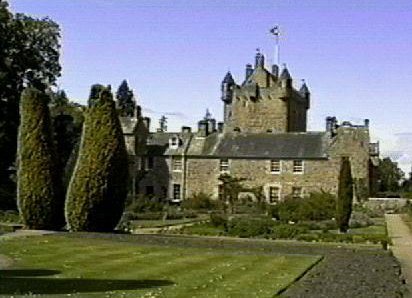
Set in wooded grounds, the present buildings date from the early 14th century. The old drawbridge over the defensive ditch now takes tourists into the central square tower from where you can tour the dining room, pink bedroom, tapestry bedroom and drawing room. The latter incorporates a hidden trapdoor used to take any unwelcome visitor straight down a chute carved within the thickness of the castle wall and into a dungeon which has no other means of entry or exit. It was only discovered in 1976 during building work on the room above and has now been partially opened up for viewing.
Near there in the very bowels of the castle stands an ancient tree which is reached via a narrow stone stairwell. Legend has it that one day the Thane of Cawdor set a donkey laden with gold to roam the countryside, saying that wherever it chose to rest for the night would become the site of his castle. The donkey lay down by a tree and the castle was built around it. For many years it was thought to be a hawthorn, but it is in fact a holly tree which died in about 1372. The Cawdor Toast is 'Flourish the Thorn!'
After passing through the old and new kitchens, the tour ends with the larder which houses a peculiar mixture of old cycles and fascinating artefacts such as the gardener's snow shoes.
Outside, the blue bridge spans Cawdor burn (a stream) which flows into the River Nairn. Cross it and you will find the start of many signposted nature trails in the vast expanse of woodland.
The walled garden is also worth a visit. It provides a colourful contrast to the stony backdrop of the castle. In the summer, flower beds of reds, oranges, purples and whites vie for attention with the tunnel of roses and Copper beeches.
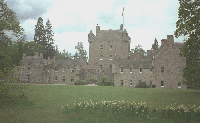 You will also notice the huge iron yett across the castle entrance. This was brought from nearby Lochindorb Castle around 1455 when the Scottish Privy Council instructed the Thane of Cawdor to dismantle it after it had been forfeited by the Earl of Moray.
You will also notice the huge iron yett across the castle entrance. This was brought from nearby Lochindorb Castle around 1455 when the Scottish Privy Council instructed the Thane of Cawdor to dismantle it after it had been forfeited by the Earl of Moray.
The castle and grounds are open from early May to mid-October between 10am and 5.30pm. Disabled access to the grounds and some parts of the castle. Admission charge: 5 pounds for adults. Over 65s and disabled people: 4 pounds. Children (5-15 years): 2.70 pounds. Blind people are given free entry. Family tickets costing 13.50 pounds are available for 2 adults and up to 5 children. You can also get tickets which allow access to only the gardens, grounds and nature trails - these cost just 2.70 pounds. (1997 prices given)
Souvenir shop and licensed restaurant. Picnic area. The castle's 9-hole golf course is also open from May to October and costs just 4 pounds for a round. Telephone 01667 404 615 / Fax: 01667 404 674.
Two ghosts are said to haunt the premises, one a lady in a blue velvet dress, the other is thought to be John Campbell, the first Lord Cawdor.
One of most fascinating stories related to Cawdor dates back to the end of the 15th century when following the untimely death of the 8th Thane, the sole heiress was his baby daughter Muriel Calder. A party of Campbells forcibly took her from Kilravock Castle where she was staying with her grandmother at harvest time. Her quick-witted nurse branded her on the hip with a red-hot key so that she could be identified by the family were she ever found again. The tip of her little finger was bitten off to also help with subsequent identification. Only a very young child, she was taken by the men to Inveraray Castle. When she came of age in 1510 or 1511, at 12 years old, she was married to Sir John Campbell, the Earl of Argyll's son. Despite this traumatic beginning, the 'red-haired lassie' would seem to have enjoyed her life to a large extent and even became Thaness of Cawdor herself after her husband died in 1546. She lived until 1575.
Kathryn Lynn Davis has written a novel which encompasses some of this story, particularly the romance of Muriel and John at Kilchurn Castle. Child of Awe can be bought online as an inexpensive paperback from Amazon.com.
 Cawdor Castle
Cawdor Castle